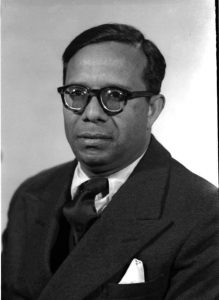 Humayun Kabir (Bengali: হুমায়ুন কবির) was a Bengali politician and writer. Kabir was born on 22 February 1906 in Komarpur village near district town of Faridpur District currently in Bangladesh. His father, Khan Bahadur Kabiruddin Ahmed, was a Deputy Magistrate in Bengal.
Humayun Kabir (Bengali: হুমায়ুন কবির) was a Bengali politician and writer. Kabir was born on 22 February 1906 in Komarpur village near district town of Faridpur District currently in Bangladesh. His father, Khan Bahadur Kabiruddin Ahmed, was a Deputy Magistrate in Bengal.
He came first, with star marks, in his matriculation examination in 1922. He was educated at Presidency College, Calcutta, completing his Intermediate in Arts (I.A.) in English with first class third, and Calcutta University, where he completed his B.A. (Honours) and M.A. in English with first class first. He won a scholarship to Exeter College, Oxford where he completed his degree in ‘Modern Greats’, i.e. Philosophy, Political Science, and Economics with a first class in 1931.
In 1932, he was invited by Sarvapalli Radhakrishnan to join as a lecturer at the newly established Andhra University. Later, he was a Joint Education Adviser, Education Secretary and then Chairman of the University Grants Commission in Delhi. He was the Minister of State for Civil Aviation, Education Minister of India twice, under the Prime Ministerships of Jawaharlal Nehru and Lal Bahadur Shastri. He was also Scientific Research and Cultural Affairs Minister. In 1965, Indira Gandhi offered him the Madras Governor’s post, which he declined. From 1956-62, he was a member of the Rajya Sabha and from 1962-69 he was a member of the Lok Sabha, representing Basirhat constituency in West Bengal.
Kabir was the editor of Maulana Abul Kalam Azad’s biography India Wins Freedom. Maulana Azad dictated his biography to him in Urdu, which Kabir translated in English.
He was one of the co-drafter of the UNESCO 1950 statement titled The Race Question.
His daughter Leila Kabir was married to Indian politician (the late) George Fernandes. His nephew (the late) Altamas Kabir was the 39th Chief Justice of India (CJI) and his niece Shukla Kabir Sinha was a judge of the Calcutta High Court.
His younger brother (the late) Jehangir Kabir is a politician in West Bengal, India.
In 1930, after he returned from Oxford, he married Shantilata Dasgupta, a Brahmo lady which created a huge uproar in the society.
Humayun Kabir was an eminent literary figure. He edited several periodicals. In the history of Bangla periodicals, Kabir will be remembered for the high quality quarterly Chaturanga (1939-69). He also edited reports and books for many local and foreign organisations. A collection of Bangla short stories and poems, Green and Gold (1958) deserves special mention.
Humayun Kabir was a poet, novelist, and essayist. He made his literary debut in 1928 with Svapnasadh, Sathi (1930) and Astadashi (1938) followed. The poems in these volumes reflect his romanticism in which he followed the tradition of rabindranath tagore. Equally fluent in Bangla and Urdu, he translated Musaddas-e-Hali into Bangla.
Humayun Kabir also wrote short stories and novels. His novel, Nadi O Nari, was published in 1945. Its English version, Men and Rivers, was also published at about the same time. This novel, which tells about the lives of Bengali Muslims living along the banks of the Padma, was made into a film in Dhaka in 1956. Humayun Kabir was a remarkable essayist. His very on philosophy, literature, education and sociology made remarkable contributions to the processes of Bengali intellectual thinking. Some of his well-known books are Imanuel Kant (1936), Sharat Sahityer Multattva (1942), Banglar Kavya (1945), Marksbad (1951), Naya Bharater Shiksa (1955), Shiksak O Shiksarthi (1957), Mirza Abu Talib Khan (1961), Delhi-Washington-Moscow (1964), Kant on Philosophy in General (1935), Poetry, Monads and Society (1941), Muslim Politics in Bengal (1943), Rabindranath Tagore (1945), The Indian Heritage (1946/60), Science, Democracy and Islam (1955), Education in India (1956), Studies in Bengali Poetry (1964), The Bengali Novel (1968), Education for Tomorrow (1968), Minorities in a Democracy (1969) etc.
For his contributions to knowledge he was honoured with awards by universities such as Aligarh (1958), Annamalai (1959), Khairagarh (Madhya Pradesh, 1961), Viswa-Bharati, Mahishur and Athens. Well-known as an orator, Humayun Kabir was invited to speak by many universities at home and abroad. At Oxford he delivered the Herbert Spencer Lectures on Einstein and Russell. In 1957 he spoke at the Kagmari Conference of Maulana Abdul Hamid Khan Bhasani as leader of the Indian delegation. He died in Calcutta on 18 August 1969.
*****
This post, from the group Memories Of Former East Pakistan (1947-1971), has been shared by Ananya Jahanara Kabir – the great-neice of Humayun Kabir.
She rightly reminded that though it was posted “in a group remembering East Pakistan, my great-uncle was an important part of the decolonising generation of Indian nation-builders”.
Ananaya Jahanara Kabir is Professor of English Literature at King’s College London. She is currently Humboldt-Forschungspreis-Preisträgerin at Freie Universität Berlin.
Where can we get his books